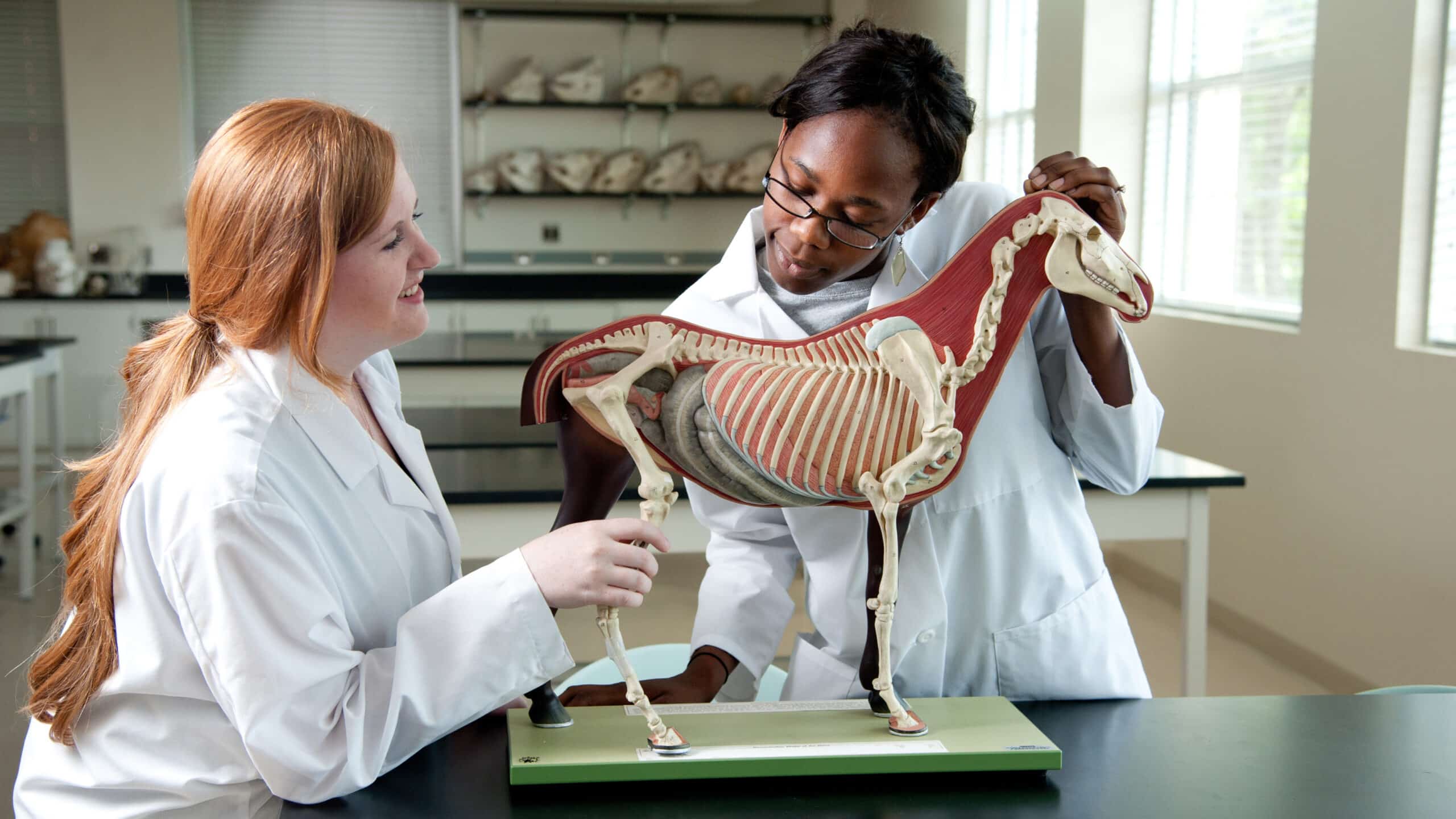For Immediate Release
In a pair of new studies, researchers from North Carolina State University found that as veterinary students progress through their coursework, their beliefs about dog breeds’ pain sensitivity and trustworthiness change, becoming more in line with those of practicing clinicians and faculty. The work is important in understanding how veterinary attitudes and culture are being transmitted to future veterinarians, particularly in cases where the culture may be at odds with reality.
“In a previous study, we found that while dog breeds differ in their sensitivity to pain, it didn’t necessarily reflect the beliefs veterinarians held about which breeds might be more sensitive,” says Margaret Gruen, associate professor of behavioral medicine at NC State and corresponding author of the new work. “So we wanted to look at when these attitudes are formed by students and what this might mean.”
Gruen and lead author Rachel Caddiell created a cross-sectional survey to get a snapshot of different groups’ attitudes about pain sensitivity and trustworthiness in dogs. They surveyed members of the general public, undergraduates in pre-veterinary courses, veterinary students in different stages of their education, veterinary faculty and practicing clinicians. Caddiell is a postdoctoral researcher at NC State.
The survey asked participants to rate pain sensitivity as well as their personal feelings of warmth or coolness about 10 dog breeds: Siberian husky, Labrador retriever, border collie, Boston terrier, German shepherd, golden retriever, Jack Russell terrier, Maltese, pitbull-type dog and Chihuahua. These breeds were selected because veterinarians and the general public rate these dogs differently in terms of their pain sensitivity. This was similar to the previous study on pain; however, in the new study, participants were also asked about their trust of these same breeds in a variety of situations.
Overall, the survey found that as students move from undergraduate studies through school, their attitudes become more in line with those of professors and practicing veterinarians.
For example, in terms of warmth and trustworthiness, members of the general public are two times more likely to trust Chihuahuas with children than veterinary faculty and staff. And the general public is two times more likely to adopt a Siberian husky or a Maltese, compared to veterinary faculty and staff.
“We saw a correlation with feelings of warmth toward a breed and pain sensitivity ratings that differ between the public and veterinarians,” Gruen says. “For the general public, the warmer the feelings, the more sensitive they rate the dog. But that changes as they move through the educational process – warmth correlated with ratings of lower pain sensitivity. For example, the public rates golden retrievers as more sensitive, while veterinary students, faculty and staff rate them much less sensitive, likely due to their behavior in the clinic.”
There were some surprises. Undergraduates with clinical experience gave ratings that fell somewhere in between those of the general public and those of clinicians. For example, undergraduates who had clinical experience rated Chihuahuas, Siberian huskies, and German shepherds as more sensitive to pain – in alignment with the veterinarians’ beliefs. And veterinary students in their third and fourth years tended to fall on the far side of the scale, rating breeds as even more sensitive than faculty and clinicians.
“So while we see a connection between pain sensitivity and warmth, what does that really mean?” Caddiell says. “A particular breed’s temperament, like standoffishness toward strangers or how afraid they may be feeling at the vet’s office, could be affecting these ratings as well. This points to cultural transmission, not just data transmission, in veterinary education.”
While she doesn’t think that this cultural transmission is necessarily always negative, or even deliberate, Gruen hopes that these studies can be a jumping off point for separating behavior from biology when training future veterinarians.
“From an educational standpoint, we all need to think critically about what we mean when we talk about pain – if we’re talking about behavior or stress, that’s different,” Gruen says. “And we need to think carefully about the language we use when we’re talking about biological versus behavioral traits, because this language could affect the way clinicians think about canine patients.”
The studies appear in Scientific Reports and were supported by the American Kennel Club Canine Health Foundation (grant 67627). NC State colleagues Duncan Lascelles, Kenneth Royal, and Kimberly Ange-van Heugten, as well as Brigham Young statistician Philip White, also contributed to the work.
-peake-
Note to editors: Abstracts follow.
“Veterinary education and experience shape dog breed pain sensitivity beliefs”
DOI: 10.1038/s41598-023-40671-y
Authors: Rachel M.P. Caddiell, B. Duncan X. Lascelles, Kenneth Royal, Kimberly Ange-van Heugten, Margaret E. Gruen, North Carolina State University; Philip White, Brigham Young University
Published: Aug. 24, 2023 in Scientific Reports
Abstract:
Over 95% of veterinarians report believing that dog breeds differ in pain sensitivity. Ratings made by veterinarians differ from those of the general public, suggesting these beliefs may be learned during veterinary training or clinical experiences. Therefore, the current study’s primary objective was to evaluate dog breed pain sensitivity ratings during veterinary training and compare these ratings to those of the general public and undergraduates in animal-health related fields. Using an online survey, members of the general public, undergraduates, veterinary students across all four years, and veterinary faculty and staff rated pain sensitivity of 10 different dog breeds, identified only by their pictures. Compared to the general public and undergraduates, veterinary students rated pain sensitivity across breeds of dog more similarly to veterinary faculty and staff. Further, when undergraduates had clinical experience, they also rated certain dog breeds in a similar way to the veterinary students and professionals. Our findings suggest that veterinary education and clinical experiences influence pain sensitivity ratings across dog breeds. Future research should identify how these pain sensitivity beliefs are communicated and whether these beliefs affect recognition and treatment of pain by veterinarians.
“Veterinary education and experience shape beliefs about trust among dog breeds”
DOI: 10.1038/s41598-023-40464-3
Authors: Rachel M.P. Caddiell, B. Duncan X. Lascelles, Kenneth Royal, Kimberly Ange-van Heugten, Margaret E. Gruen, North Carolina State University; Philip White, Brigham Young University
Published: Aug. 24, 2023 in Scientific Reports
Abstract:
Dog breed stereotypes are frequently used to inform people’s expectations about canine behavior, despite evidence that breed is largely uninformative in predicting individual dog behavior. Further, these beliefs differ among populations. However, it remains unknown how ratings of warmth toward a breed are associated with ratings of other social behavioral domains, and whether differences exist between populations with varying experience with dogs. The purpose of this study was to evaluate ratings of trust and warmth among survey respondents including veterinary students, veterinary faculty and staff, undergraduates in animal-health related majors and members of the general public. Using an online survey, respondents rated their likelihood to trust a dog in varying scenarios for 10 different dog breeds. Additionally, respondents used a feelings thermometer to rate how warm or cool they felt towards each breed. Findings revealed differences in feelings thermometer and trust ratings across populations. All ratings were lower among the veterinary academic respondents compared to the general public and undergraduates. Veterinary students further along in their training, as well as undergraduates with clinical experience, reflected perceptions similar to those of the veterinary faculty and staff providing support for cultural transmission of beliefs during veterinary education and training.
- Categories:



